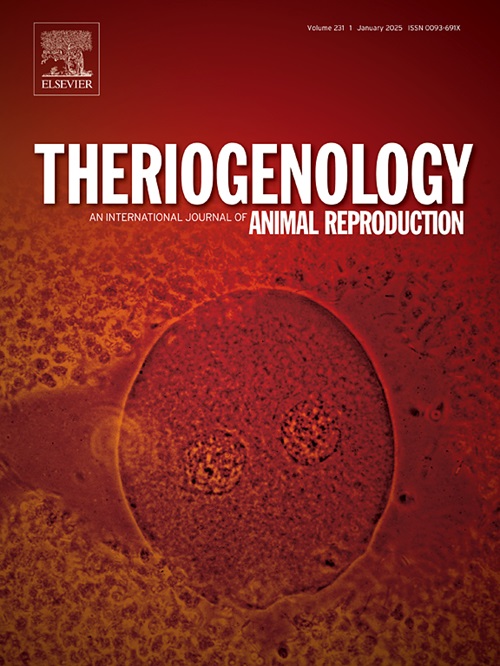Kisspeptin对家兔排卵的影响:排卵、内分泌和组织学反应的综合研究
IF 2.4
2区 农林科学
Q3 REPRODUCTIVE BIOLOGY
引用次数: 0
摘要
哺乳动物的生殖功能由下丘脑神经元调节,下丘脑神经元分泌Kisspeptin (Kp),一种刺激促性腺激素释放激素(GnRH)分泌的神经肽,触发垂体促性腺激素(LH和FSH)和性腺类固醇。本研究评价了Kisspeptin-10 (Kp10)对家兔的促排卵作用,并将其与GnRH类似物促性腺激素(gonadorelin)的效果进行了比较。将已产新西兰白×加利福尼亚公羊分为3组:对照组(0.5%生理盐水,静脉注射)、GnRH组(促性腺激素20 μg,静脉注射)和Kp10组(250 μg,静脉注射)。Kp10诱导87.5%的雌性排卵,与GnRH组观察到的反应相匹配,每个排卵雌性的黄体(CL)数量相当(分别为12.9±1.4和14.6±1.4 CL/雌性)。第7天,gnrh处理组血浆孕酮(P4)显著高于kp10处理组(25.12±4.17 ng/mL vs 9.47±4.17 ng/mL);p & lt;0.0211),而非排卵对照组的P4浓度最低(0.86±0.12 ng/mL)。血浆雌二醇(E2)水平在不同天、不同组间无显著差异,第0天和第7天的平均值分别为32.74±4.33 pg/mL和37.27±5.49 pg/mL。组织学分析证实,Kp10促进排卵前卵泡发育和CL形成,反映了GnRH的作用。此外,Kp10促进血管生成,表现为在更发达的滤泡和CL中血管内皮生长因子(VEGF)表达增加。这些结果表明,Kp10可以替代GnRH诱导家兔排卵,尽管需要进一步的研究来探索最佳的类似物、剂量和给药途径。本文章由计算机程序翻译,如有差异,请以英文原文为准。
Effects of Kisspeptin on rabbit ovulation: a comprehensive study of ovulatory, endocrine and histological response
Mammalian reproductive function is regulated by hypothalamic neurons that secrete Kisspeptin (Kp), a neuropeptide that stimulates gonadotropin-releasing hormone (GnRH) secretion, triggering pituitary gonadotrophins (LH and FSH) and gonadal steroids. This study evaluated the effect of Kisspeptin-10 (Kp10) on ovulation induction in rabbits, comparing its efficacy with that of the GnRH analogue gonadorelin. Multiparous New Zealand White × California does were assigned to three groups: control group (0.5 % saline solution, i.v.), GnRH group (20 μg gonadorelin, i.m.), and Kp10 group (250 μg Kp10, i.v.). Kp10 induced ovulation in 87.5 % of does, matching the response observed in the GnRH group, with a comparable number of corpora lutea (CL) per ovulated doe (12.9 ± 1.4 vs 14.6 ± 1.4 CL/doe, respectively). On day 7, plasma progesterone (P4) was significantly higher in ovulated GnRH-treated does than in Kp10-treated ones (25.12 ± 4.17 vs 9.47 ± 4.17 ng/mL; p < 0.0211), while non-ovulated controls exhibited minimal P4 concentrations (0.86 ± 0.12 ng/mL). Plasma estradiol (E2) levels showed no significant differences across days or groups, with mean values of 32.74 ± 4.33 pg/mL on day 0 and 37.27 ± 5.49 pg/mL on day 7, respectively. Histological analysis confirmed that Kp10 promoted preovulatory follicle development and CL formation, mirroring GnRH effects. Additionally, Kp10 enhanced angiogenesis, indicated by increased vascular endothelial growth factor (VEGF) expression in more developed follicles and CL. These results suggest that Kp10 could be an alternative to GnRH for ovulation induction in rabbits, although further studies are needed to explore optimal analogues, doses, and administration routes.
求助全文
通过发布文献求助,成功后即可免费获取论文全文。
去求助
来源期刊

Theriogenology
农林科学-生殖生物学
CiteScore
5.50
自引率
14.30%
发文量
387
审稿时长
72 days
期刊介绍:
Theriogenology provides an international forum for researchers, clinicians, and industry professionals in animal reproductive biology. This acclaimed journal publishes articles on a wide range of topics in reproductive and developmental biology, of domestic mammal, avian, and aquatic species as well as wild species which are the object of veterinary care in research or conservation programs.
 求助内容:
求助内容: 应助结果提醒方式:
应助结果提醒方式:


